#YOU HAD TO PICK NAZIS AS YOUR EXAMPLE OF REAL PUNKS???
Explore tagged Tumblr posts
Text
The Anti-Spider-Girl Agenda within Marvel
In 1998 Tom DeFalco, former EIC of Marvel, created Mayday Parker/Spider-Girl. Her debut did gangbusters and a first edition of it still fetches a lot of cash. She got a solo series in 1999 which launched an entire interconnected universe of characters, the MC2 universe.
The universe ultimately wrapped up in 2010 but throughout that time Mayday was being regularly published in one format or another, she was even the FIRST ever Marvel character to get a digital ongoing series before it went to print. An impressive accolade to add to the fact that she still holds the record for the female Marvel solo protagonist with the longest running continuous series. That is to say no breaks or relaunches, just over 60 straight monthly issues...
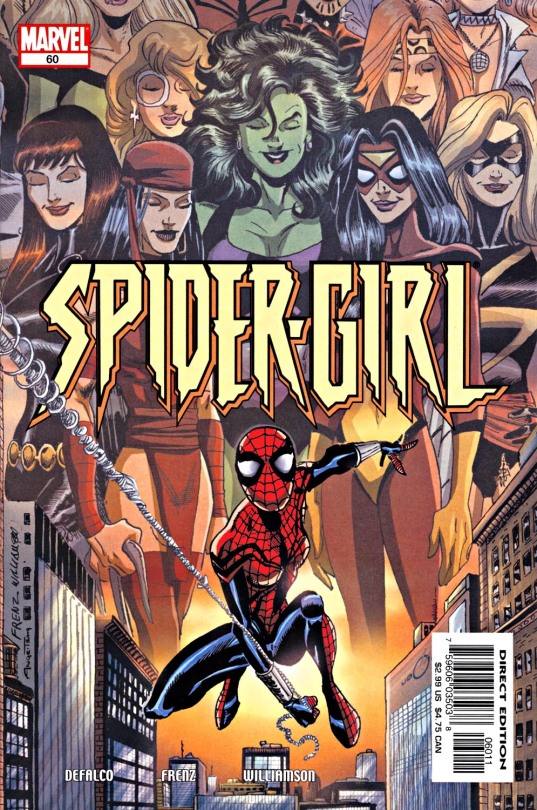
... And THEN she went another 40 straight issue for good measure before finally being continued in a relaunch.
So, given how the anniversaries of both her debut and the debut of her series/the MC2 universe have come and gone I have to ask...why has there been 0 acknowledgement from Marvel?
We’re in the middle of a 2099 celebration, and that imprint (that lasted less time and was arguably less successful) was an on and off presence between 2013-2017.

We’re going to get something acknowledging Iron Man 2020 a character who is hardly in the zeitgeist of Marvel fandom to the same extent as Spider-Girl.
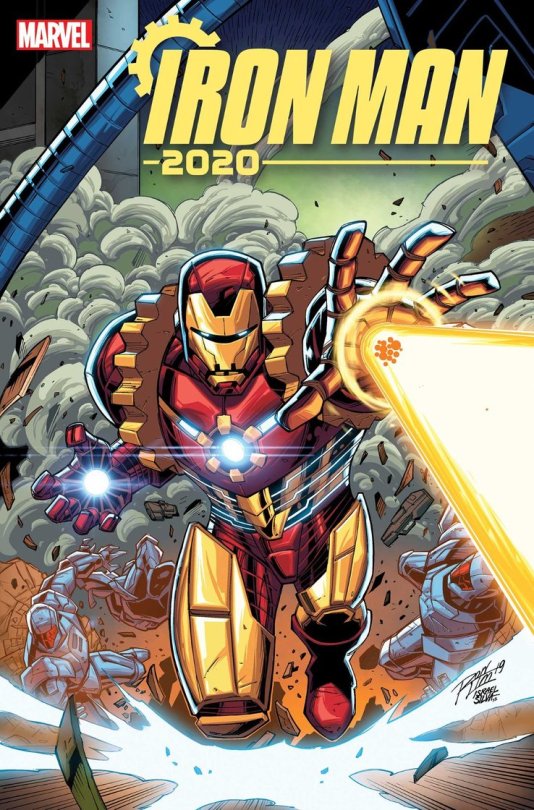
Now in fairness both of those examples are reliant upon the literal names of both properties. It does make a certain amount of sense to celebrate the 2099 line in a year ending in the number 9, thus bringing us ever closer to the real life year 2099. Equally it makes sense to revive Iron Man 2020 during well...the year 2020.
But then you get to Marvel celebrating the Earth X stuff. Now for all you out there who haven’t read the Earth X stuff I want you to ask yourself a question and be very honest with yourselves. How much do you actually know about the Earth X universe just via osmosis, without having read it. I’m willing to bet it ain’t much if anything and what you do know probably amounts to:
It was Marvel’s answer to Kingdom Come
Alex Ross did art for it
MAYBE you know Norman Osborn was the President
Oh and you probably remember that really cool Venom/symbiote looking character who was a version of Spider-Girl!
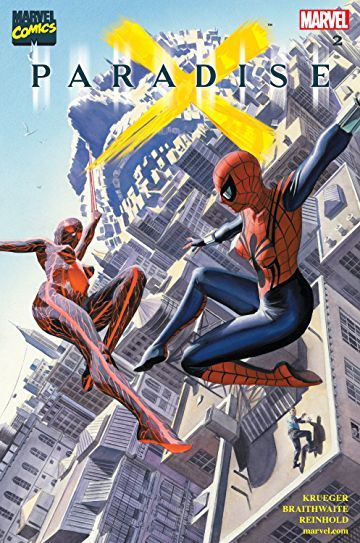
Golly, it’s almost like if Marvel are going to celebrate the not-that-well-remembered Earth X line (which like 2099 also lasted for less time than the MC2 universe) then they should do SOMETHING (beyond releasing some trades) to mark EITHER of the appropriate anniversaries for Spider-Girl and/or the MC2 universe as a whole.
But no. We get some trades and also Mayday appeared in Spider-Geddon for a few issues...at no point being solely in the spotlight...
This my friends is simply the latest in a very, very, very, very, very long list of instances where Mayday/the MC2 brand is mistreated.
And a lot of that mistreatment I think is due to Tom DeFalco’s hand in creating Mayday and the MC2 universe. Because frankly, in particular relation to the MC2 universe, DeFalco’s work has also been mistreated in recent years.
The facts are:
Mayday’s ongoing (Spectacular Spider-Girl volume 2) was turned into a mini in spite of solicits
She was cancelled so Anya Corazon could get the name Spider-Girl
The very next time she shows up her Dad is killed off, thus fundamentally wrecking the whole premise for her character
The guy who killed her Dad proceeded to treat her as an abused babysitter
That same guy finished things off by removing her unique name and costume
That same guy (Slott) in the same run before and after Spider-Verse wrecked other elements from DeFalco’s ASM work AND threw shade at his origin for MJ, calling it reductive
Slott also was hired by DeFalco and had to uncomfortably admit he’d conned the man. Which combined with everything else makes me wonder if DeFalco maybe threw some shade Slott’s way back when he was an intern. Like he looked upon him as underhanded and unworthy of his place in the company, and Slott knew that and resented DeFalco for it. And again, being EIC earns enemies and DeFalco was the EIC when Slott started
Slott also wrecked Ben Reilly a character DeFalco did not create but had strong associations with.
During secret wars the story focused HEAVILY upon Hope Pym, Stinger and Ant-Man at a time when coincidentally the Ant-Man movie was happening.
During Secret Wars the same writer who wrecked her in Spider-Verse COINCIDENTALLY happened to a story about the daughter of Spider-Man who was born during the 1990s, but it was his own OC
During Secret Wars, Mayday appeared on the cover of one of the ongoings she was set to appear in, but it was then revised to be Anya
Mayday when she began appearing regularly in a new title was seemingly killed off early into it and didn’t appear for awhile, not getting much spotlight when she did
Mayday had to share her spotlight moments in Spider-Geddon with Anya (again), still wasn’t allowed to be called Spider-Girl again, and the story was mostly about Annie not her.
She was going to appear in the USM cartoon but then that was totally changed to be a gender flipped Peter Parker
Eric Masterson/Thunderstrike, another well remembered DeFalco creation, has also gotten little-no attention this decade despite it being a 20th/25th anniversary of him too. One of the more notable acknowledgments of his character was turning him into a Neo-Nazi for Spider-Punk to beat up.
Spider-Girl’s VERY SUCCESSFUL digests were discontinued but conveniently other digests for other Marvel properties either continued or started up after Mayday’s were discontinued.
The ‘complete’ Spider-Ham trade paperbacks ‘conveniently’ do not include Spider-Ham’s equivalent character for Spider-Girl, Swiney-Girl
Gee that’s an AWFUL lot of coincidence, especially when you consider fucking Spider-Ham has been getting more attention from Marvel than Mayday; and that was BEFORE Into the Spider-Verse came out.
I’m sorry, but it’s really, really, really, really, really, really obvious that there is an anti DeFalco/Spider-Girl/MC2 sentiment within Marvel.
But why you may ask?
There are a few reasons for that. The biggest one though is that Tom DeFalco is the former EIC of Marvel comics.
At the time of me writing this, Axel Alonso recently stopped being EIC of Marvel and no bad words are muttered about him. People in the industry equally have little bad to say about Joe Quesada, especially those within Marvel.
But then again...Joey Q is still working for Marvel and in a position ABOVE the EIC. He never stopped working for Marvel even when he stopped being the EIC. And Alonso, one of Quesada’s right hand yes men conveniently took over for him and do you know he didn’t run the company all THAT differently to his former boss. Funny that right?
It’s almost as funny as how other former EICs of Marvel absolutely don’t have the same treatment. Jim Shooter is routinely BLASTED by countless fans and creators, especially the ones who worked under him, even though he oversaw arguably the height of Marvel comics’ creative history. Bob Harrass and his decisions are often talked about less than flatteringly. Tom DeFalco meanwhile had a whole disparaging phrase named after him.
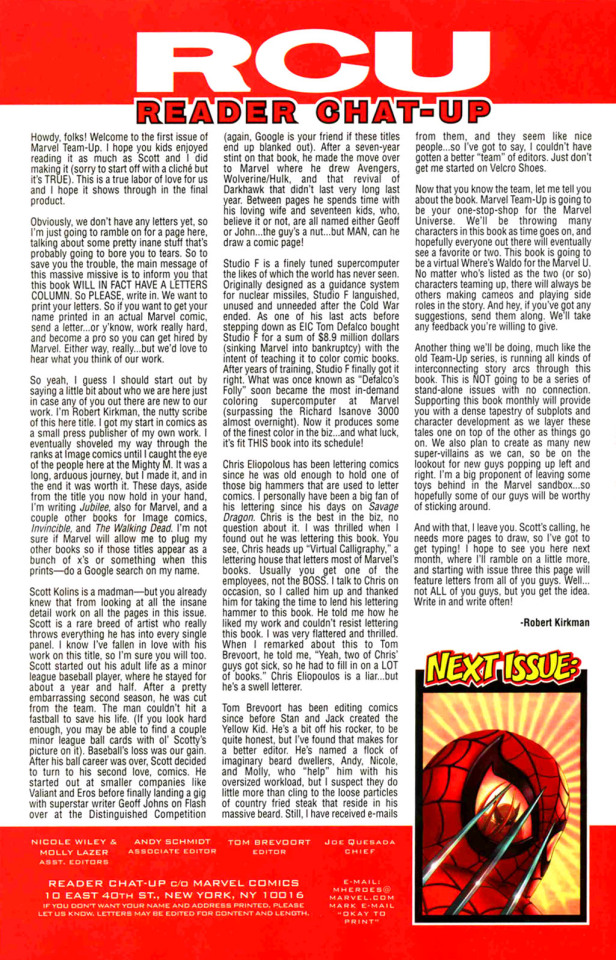
Yes. That is is a real life Marvel letter page from the mid-2000s literally using the term ‘DeFalco’s Folly’ in reference to a former Marvel EIC and outright BLAMING HIM for their bankruptcy in the 1990s.*
When you are the EIC you make enemies. It’s rare that the boss of any business isn’t resented on some level by their employees. And your words take on much more meaning that what you simply say, being subject to misinterpretation.**
But now imagine you are the boss of a bunch of creative nerds (for most creators of superheros are nerds). Creative people A LOT of the time tend to be fairly sensitive as is, it’s likely critical to their craft. Nerds historically have tended to be sensitive (that’s neither a good nor bad thing). If you are the boss of those people, hoo boy will you ever make enemies. Tom DeFalco in fact once told a fellow editor that an innocuous comment about how an artist under said editor’s employ drew a character was being taken by the artist as an insult to their whole career.
NOW imagine all that and also under your tenure the company goes bankrupt and a lot of people lose their jobs?
Enemies. Enemies galore.
Even if it wasn’t necessarily your fault, you are the most visible person in authority so you get the blame. If the internet wasn’t that much of a thing do you really think that Ike Perlmutter would be the guy who got the blame for deep sixing the X-Men and F4 in the 2010s? Hell no, it’d have been Axel Alonso and/or Tom Brevoort.
So yeah, Mayday was DeFalco’s baby and the MC2 universe more than anything was the logical extrapolation from the Marvel universe as it existed under HIS tenure as EIC. It’s very much seen as representative of DeFalco himself. Thus if people have an issue with DeFalco, they’re not going to do all that much positive as far as his stuff is concerned, in particular if it gives him anything like royalties.
But on top of all of that I think Spider-Girl and the MC2 universe simply conceptually lean against Marvel’s ‘party line.
I didn’t notice this, but it was pointed out to me by an acquaintance that the MC2 universe is VERY similar to DC’s Earth 2 concept, wherein the classic heroes are older and/or retired with their immediate descendants picking up their mantles. Marvel and DC have this petty and asinine pissing contest between them, with many within Marvel even outright hating the fact that they have numbered universes like DC. It’s likely (definitely) the reason Earth 616 was rebranded as ‘Earth Prime’. This of course won’t stop them ripping off DC if they think it’ll make bank
The MC2 universe was a universe of OPTIMISM. In particular in the 2000s, and this attitude has definitely lingered, there is this emphasis upon cynicism and at best Pyrrhic victories within Marvel. Partially this is due to a misinterpretation of what ‘realism’ means, but partially this is due to misguided belief that controversy sells and pissing the fans off makes bank.
The MC2 universe is very old school. It’s deliberately designed to be nostalgic and feel Silver Age in it’s sensibilities. this is why the violence is not all that gory, the sexual references are at best reserved and tasteful and there’s that optimism I talked about. not to mention it kicks back hard against the decompression/writing for the trade storytelling model Marvel typically employs and has typically employed for almost 20 years now. Whether it’s simply because the universe doesn’t conform, or because Marvel views anything ‘retro’ as bad because it isn’t ‘modern’ (with no inspection of whether the modern trends are a GOOD thing) the end result is that the MC2′s sensibilities are not in line with how Marvel WANTS their comics produced.
Then you have Mayday herself. Mayday is a living symbol of both the Clone Saga and the Spider Marriage. Whilst Marvel are NOW willing to more openly reference the Clone Saga, few people i any kind of positions of power look upon it (or even aspects of it) with anything but disdain and embarrassment. Dan Slott for instance openly hated it. As for the Spider Marriage...I mean do I even need to explain that one?
I’m sure a frustrating fact for Marvel during Spider-Girl’s publication, and something likely passed down to Axel Alonso when he was handpicked by Quesada, was that the book refused to die. Spider-Girl was scheduled for cancellation multiple times and defied the odds multiple times. Marvel 90% of the time won’t kill a book if it’s making a profit (especially in a day and age when they were still feeling the fallout from bankruptcy) so they kept Spider-Girl around, but because it was so against the party line I’m VERY sure they’d have LIKED to have had the justification for killing the title. That’s likely why they shuffled her onto a digital platform in 2009. Amazing Spider-Girl did poorly enough to justify cancelling it but not so poorly that they couldn’t still make money from it. Another relaunch would’ve boosted sales for the series, but making it a digital series at a time when hardly anyone read digitially (let alone PAID for it), now that’s a shrewd manoeuvre. You make SOME money from it, you pay lip service to keeping it alive and appeasing very upset Spider-Marriage fans, but you’ve essentially guaranteed it’s failure long term.
Part of that annoying success was those incredibly successful digests that were possibly indoctrinating a lot of young impressionable readers on a character/brand Marvel wanted to bury and aspects of their flagship character (read: a married older Peter Parker) that they wanted to bury. Hence Spider-Girl digests disappeared but conveniently there were still digests for Ultimate Spider-Man sold featuring a young, buffoonish, Avengers worshipping Peter Parker.
Oh...and she also had the incredibly brand sexy name ‘Spider-Girl’ that Joe Quesada wanted for his own precious pet OC character, Anya Corazon. In fact Mayday was going to be rebranded as Spider Woman in Spider-Girl #75, specifically so that Anya Corazon could be given the name Spider-Girl. Years later Mayday was cancelled specifically for that purpose.
tl:dr There is a VERY OBVIOUS anti Tom DeFalco/Spider-Girl/MC2 agenda within Marvel.
My hope is that it’s rooted out, hopefully as a result of the 20 year nostalgia factor kicking in sooner of later (her series was most prevalent in the 2000s) and more female creators coming into the industry.
*Which is very much unfair. There is rarely one singular decision that results in bankruptcy. So whilst DeFalco making a single purchase might’ve been a contribution (emphasis on ‘might’) the idea that it was THE ultimate cause of Marvel’s problems is ridiculous.
Marvel were heading for the shitter the moment Ron Perleman purchased it in the 1980s. They were the victims of a ‘pump and dump’ scheme wherein sleazy yet clever financial people showed up, created a bubble to make a load of money, then moved on to the next thing when the bubble burst. To my understanding a similar thing occurred with baseball cards.
** In fact DeFalco’s friend, Ron Frenz, has spoken about how he was witness to DeFalco saying one thing and the people listening to him hearing and acting upon it in a totally different way than was intended.
The same happened to Stan Lee when he made an aside about Iron Man’s lack of a nose, which resulted in his employees believing Stan wanted them to give Iron Man a nose.
P.S. You know in the 1990s when all the 2099 books got cancelled sans Spider-Man 2099, they never got a second bite of the apple.
But between the late 90s and 2000s the MC2 universe was seemed successful enough that around 2006-2007 both Spider-Girl AND the wider MC2 universe were given second volumes, even the ones that only lasted like 6 issues.
Since then there’s been at least 3 attempts to revive the 2099 universe, we’re living through the latest one.
And yet Mayday doesn’t seem to even be worthy of a spotlight issue in the current Spider-Verse series.
#Spider-Man#Spider-Girl#Mayday Parker#mc2#mc2 universe#Tom DeFalco#Ron Frenz#Thunderstrike#Eric Masterson#Dan Slott#Joe Quesada
188 notes
·
View notes
Text
Norwegian Black Metal
This is a paper I wrote for school. As the title suggests it is an overview of Norwegian Black Metal. Enjoy!
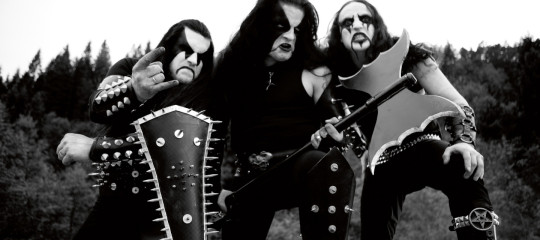
Heavy metal music is one of the most popular genres of music in the world. Its influence has reached every corner of the globe and boasts some of the most famous bands of all time. Bands like Iron Maiden, Black Sabbath, Led Zeppelin and Metallica all are Metal bands and if not, have had metal signatures. Since bands like these are so pervasive around the world, metal has reached communities in the remotest corners of the earth. South America for instance has its own strand of heavy metal boasting a band like Seplatura and Japan is another breeding ground for the music. There are many reasons why the genre is popular but one of the most important aspects is its darkness. Due to its somber nature, heavy metal tends to deal with dark subjects. Many metal songs deal with death and the devil. Normally this is just done for fun. For many teenagers, listening to songs about Satan will piss off their religious parents. Songs about death can help people cope with feelings of depression. But what if some people took typical heavy metal themes to their literal conclusion? Some kids in Norway did this. The Norwegian Black Metal scene is one of the most infamous scenes in the history of music. It ended up in the burning of over 40 churches and the murders of two people.
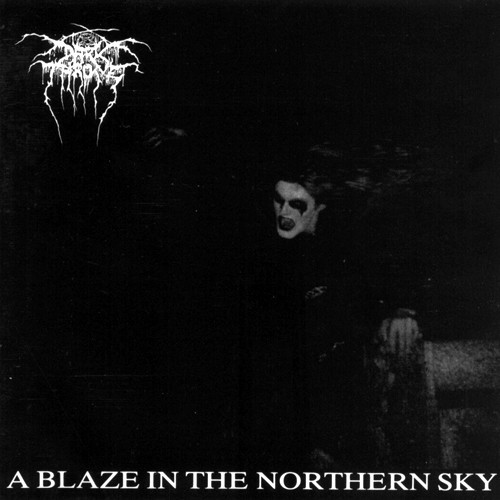
(Darkthrone - Blaze in the Northern Sky album cover)
Since black metal is a subgenre of metal, here’s a primer for the uninitiated. Sorry, I can’t cover all the metal subgenre since there are too many subgenres. Also, I will be drawing from Sam Dunn’s Metal Evolution documentary and Last Podcast on the Left’s subcategories for there is no official list of what genre these bands belong to. Metal itself is a subset of rock and roll music, defined by being driven by guitar, bass, and drums. It harbors some the most popular performers of all time like The Beatles, The Rolling Stones, Elvis Presley and Jimi Hendrix. This influenced early UK metal, which includes the two bands who pretty much defined early Heavy Metal: Black Sabbath and Led Zeppelin. Metal music was slower, darker, louder, heavier and more complex than its father Rock and Roll. The general atmosphere of the music encouraged darker lyrical themes about depression, sadness, and sometimes, the devil. A cousin of early UK Metal was shock rock. This genre included bands who would often dress up in make-up and give theatrical performances. One the most notable bands of shock rock, The Alice Cooper Band, often has a part of the concert where they simulate a decapitation of the lead singer. Out of the ashes of shock rock and early UK Metal came the New Wave of British Heavy Metal. This sub-genre was more refined and tighter than its forefathers and included bands like Iron Maiden and Motörhead. (Metal Evolution) Influenced by these genres, elements of Progressive Rock, and the speed of punk music, emerged what is possibly the most popular subgenre of metal, Thrash Metal. It includes bands like Metallica, Slayer and Megadeth. (Norwegian Black Metal part 1)
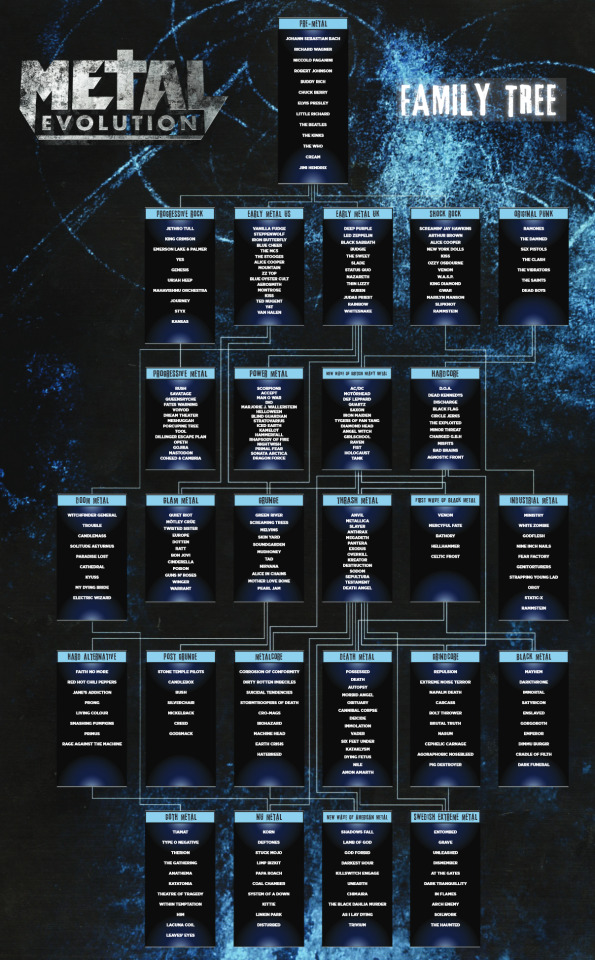
(Metal Evolution Family Tree)
The band Venom, is one of the first bands to overtly use Satanic imagery. It is key to note that they used it in jest. They also used extreme theatrics, which would contribute to the aesthetics of Norwegian Black Metal. King Diamond took this further by donning the black and white face paint in which most of the Norwegian bands would use. Then the Swedish band, Bathory would introduce the lo-fi sound that dominates Black Metal. In 1988, the band would move away from Satanic imagery into Norse mythology. They would also dip their toe into Nazi imagery. It is important to note that this was meant to shock and offend, but some of the members of the scene took some of this ideology literally. This would end up being the roots of the crimes that the scene would become infamous for. (Norwegian Black Metal Part 1)

What does Black Metal actually mean? Ross Hagen in his journal article, “Musical Style, Ideology, and Mythology in Norwegian Black Metal” defined the term as follows: “The term “black metal: initially referred simply to any extreme metal that was explicitly “satanic” in nature, but by the late 1980’s a scene had begun to emerge that self-consciously used the term as both a description of the music and essential identity.” (Hagen) Before we discuss all the wonderful activities that some of these bands engaged in, it is important to discuss what the music sounds like.
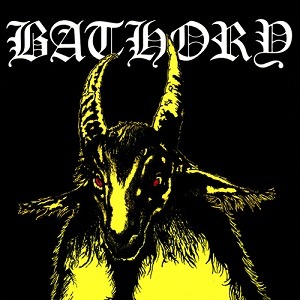
(Bathory - Bathory Album Cover)
Black metal actually deviates from many of the signature sounds that define heavy metal. For instance, some bands use keyboards to promote atmosphere. One of the trademarks of black metal is the high-pitched, banshee like vocals. Many bands choose to use this and clean vocals instead of the guttural growls that permeate many metal acts today. Full chords are used to produce a fuller, denser sound as opposed to the short blasts of power chords, which is commonly used in metal music. A technique called “buzz-picking” is often employed and allows to play more guitar strings at once, producing a fast and muddled sound. Black metal also eschews propulsive rhythmic drive, instead favoring a swirling and indistinct atmosphere. They do employ blast-beats though, which makes the drums make machine gun fire like beats, upping the tempo. Finally, black metal guitarists tend to disregard palm muting, because this technique muffles the guitar, making it more percussive, and was commonly used by Metallica in the 80’s (Hagen)
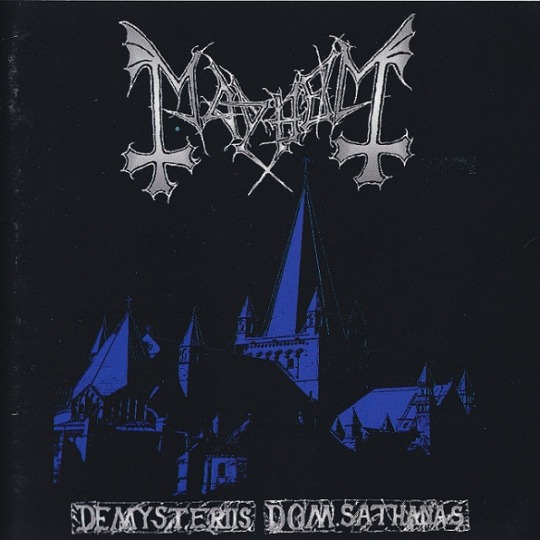
(Mayhem - De Mysteriis Dom Sathanas Album Cover)
The final piece of the black metal sound is its lo-fi sound. This genre does use the highly distorted guitars that most metal bands have used. The difference though is they use low quality production techniques. This was not only an aesthetic choice but also a by-product of all these bands being broke and unable to afford good recording equipment. (Hagen) Most bands leaned into this sound though. The leader of Burzum, Varg Vikernes (he plays a big part later), in the documentary, Until the Light Takes Us, talked about how he would purposely seek out the worst amplifiers he could find to achieve a raw sound. (Aites & Eweel) The result is a hissing sound from the guitars and the vocals. Many regard these production techniques to be cornerstones of the sub-genre. (Hagen)
Not unlike many other musical genres, the image of black metal is just as instrumental as the sound. Starting with the band logos…
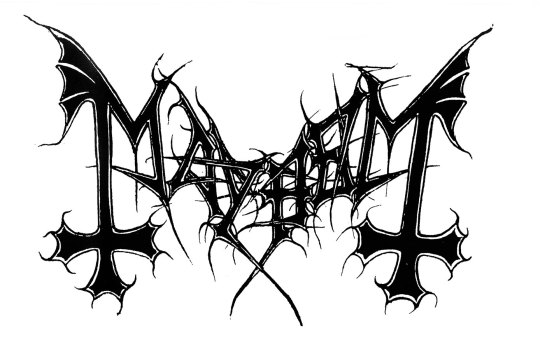
(From thetruemayhem.com)
This is a logo from one of the premier bands of the Norwegian Black Metal scene, Mayhem. Notice the truly intricate and almost illegible design. This is a visual example of the music’s exclusivity. Also included, is anti-Christian imagery, such as the inverted crosses. This logo is typical of the average black metal band logo. The bands tend to dress up in medieval armor with spikes and chains attached. They accessorize this look by posing with weapons such as swords and pikes. The most iconic part of the look is the black and white face paint that all the bands don. This is to simulate a corpse like aesthetic. The photos often mirror the music’s poor production quality, making it look raw and unfriendly. Finally, almost all black metal musicians use stage names. The names often derive from Germanic or Norse myth like Fenriz of Darkthrone. Others are inspired by the writings of Tolkien. For instance, Varg Vikernes’ stage first stage name, Count Grishnackh, and band name, Burzum. (Hagen)

(Burzum - Filosofem Album Cover)
Black metal is a genre. This means any part of the world can take part in it. What makes Norwegian black metal special, is the infamous church burnings, and murders. What is necessary to know are the major players; the band Mayhem, especially the guitarist, Øystein Aarseth, better known as Euronymous; Varg Vikernes of Burzum.
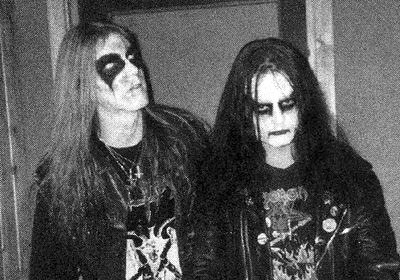
(Dead (left) and Euronymous (Right))
Mayhem was formed in 1984 in Oslo, Norway. The band was led by Euronymous. Around 1988, Per Yngve Ohlin, better known as Dead, joined the group. Dead was famously depressed and was one the first members of the scene to don the black and white face paint, to simulate a corpse like appearance. He would often cut himself during live performances to get blood flowing on stage. Dead once asked his band mates to bury him alive so as to achieve a more authentic, corpse like appearance. This all came to a head in 1991 when, Dead committed suicide by blowing his head off with a shotgun. Dead’s corpse lied in his and Euronymous’ apartment for hours. When Euronymous got home he didn’t do what most people did. He first took photos of the scene of the crime (which would be used for a cover on one of the band’s upcoming releases (warning link NSFW)). Then he is rumored to have used the fragments of his skull to make a necklace. (Norwegian Black Metal Part 2)
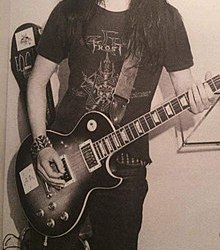
(Euronymous)
This is one of the most infamous stories from the scene. Why would any rational person do this? The thing about the Norwegian black metal scene is that these were a bunch of kids looking to rebel. Many members of these groups felt their lives were too good due to Norway’s excellent socialist economy. Since their lives were objectively good, the metal musicians found it hard to rebel like typical teenagers do. They did this by embracing Satanism and taking it literally. (That’s how you scare your parents!) This slowly became a sort of one up game of who could be more “real.” According to the “Norwegian Black Metal Part 1” by Last Podcast on the Left, this included members of these bands, who were so serious that they took pride in never smiling. (Norwegian Black Metal Part 1) This sick game of proving who could be more real was instigated by Dead’s suicide. He proved he was the most brutal by killing himself. Things grew worse when Varg Vikernes joined the scene, a man who already had problematic beliefs to begin with.
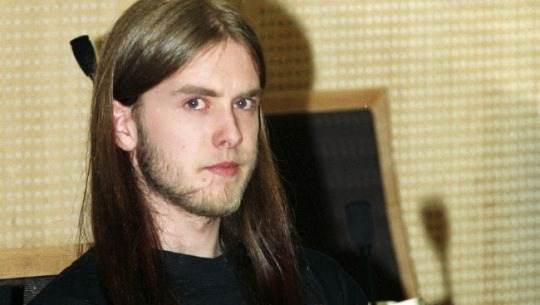
(Young Varg Vikernes)
Vikernes was born in Bergen, Norway in February of 1973. He grew up with parents who held White nationalist beliefs, which was passed down. His readings of the Lord of the Rings inspired him greatly. All though, he identified more with Sauron and the orc as opposed to the hobbits, saying that the hobbits had no personal strength. Vikernes joined the band Old Funeral in the 80’s before hooking up with Euronymous and Mayhem. From here he started the one-man group, Burzum, and it was successful. What is key to note is that Euronymous was at the heart of the Norwegian black metal scene. Alongside being in one of the central bands, Euronymous ran a record label that many of these bands used, and was quite poor at managing it. Also, he had a record shop that was the central hub of the scene. (Norwegian Black Metal Part 2)
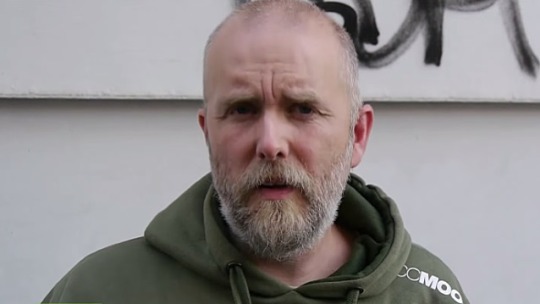
(Modern Varg)
After the time of Dead’s death this part of scene called the inner circle started to develop, and it included Vikernes. The inner circle started going out at night and burning churches. This got extensive media coverage and Vikernes told a reporter that the scene was responsible. Euronymous stoked the flames of this to gain publicity for the scene. Most of the media got scared due to the fear that this was caused by Satanism. Vikernes maintains that it was motivated to take back the land that Christianity took. He claims that the religion had erased many cultures including Norway’s Norse mythology. (Aites & Eweel)
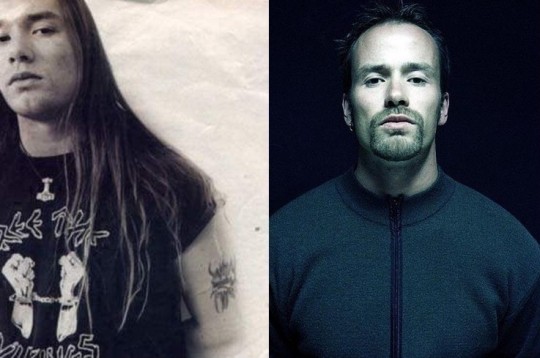
(Faust of Emperor)
Another key story involves, Faust, of the band Emperor. After a late night of drinking, Faust had an encounter with a homosexual man. He was so offended by this that he stabbed the gay man to death. The other murder involved Euronymous and Vikernes. The former owed the latter money for records sold. One night in August of ‘93, Vikernes decided to confront Euronymous at his apartment in the middle of the night. Vikernes ended up stabbing Euronymous over 20 times. Vikernes claimed it was in self-defense, but that is highly questionable. Vikernes ended up getting arrested and was sent to prison for 21 years (Norway’s Maximum) for committing the crime. He got out in 2009 after serving 15 and was released on probation. (Norwegian Black Metal Part 3)

(Fenriz of Darkthrone)
None of this nonsense is prevalent in the scene anymore. The look, sound, and themes of Satanism is still here, but not the church burnings or murders. Mayhem still exists, and is releasing records while touring. Vikernes still records under the title of Burzum, but now favors electronic music. Bands like Darkthrone are still releasing records but now the scene has calmed down and is strictly about the music. Black metal has artists from all around the world, but none of them are as infamous as the ones from Norway in the late 80’s and Early 90’s.
References
Aites, A., & Ewell, A. (Directors). (2008). Until the Light Takes Us [Motion picture on Amazon Prime]. American: Variance Films.
Dunn, S., & McFayden, S. (Directors). (2011). Metal Evolution [Motion picture on TV]. United States: Tricon Films.
Hagen, R. (2011). Musical Style, Ideology, and Mythology in Norwegian Black Metal. Metal Rules the Globe, 180-199.
Kissel, B., Parks, M., & Zebrowski, H. (2017, September 10). Norwegian Black Metal Part 1 [Audio blog post].
Kissel, B., Parks, M., & Zebrowski, H. (2017, September 15). Norwegian Black Metal Part 2 [Audio blog post].
Kissel, B., Parks, M., & Zebrowski, H. (2017, September 21). Norwegian Black Metal Part 3 [Audio blog post].
2 notes
·
View notes
Text
Star Wars is the quintessential space opera with fans around the world. Rather than write the nth article about what makes Star Wars such a phenomenon, I am going to talk about how the movies have had an impact on mostly dieselpunk.
Stick around til the end, because your intrepid reporter managed to ask Anthony Daniels, the actor who has portrayed C3P0 since the beginning of the franchise forty years ago, some questions while he was a guest at Comic Con Brussels.
‘Punk influences
These are by no means dieselpunk films, with the exception of the two Ewok movies from the 1980s, which are ultralight family-friendly movies in the style of Mad Max and The Blood of Heroes. Pretty much the same kind of setting, none of the gore or brutality and a prime example of post-apocalyptic dystopian dieselpunk (probably why they’re not mentioned anymore now, they have a hard time fitting into the rest of the universe).
And yet, with only two dieselpunk movies in a very long list, Star Wars has had a surprisingly big impact on dieselpunk.
Although, considering all the dieselpunk elements there are in the movies, including the cartoons, it is perhaps not that surprising that ‘punks are drawn to the franchise like moths to a flame.
Tatooine in Star Wars (1977)
Star Wars concept art of Coruscant (Erik Tiemens)
From the steampunk-looking, half-built C-3PO in The Phantom Menace to the post-apocalyptic feel of Tatooine and Jakku to the atomicpunk look of the planet-wide city Coruscant.
SS soldiers rally in Nuremberg, Germany in the late 1930s
First Order stormtroopers in Star Wars: The Force Awakens (2015)
From the militaristic Empire and First Order, whose uniforms and hierarchy are strongly reminiscent of Nazi Germany, to the dieselpunky underdogs of the Rebellion.
It’s the characters, the droids, the speeders, the dirt and grit and the story which inspire fans of the ‘punk genres and draw them in.
Examples of steam- and dieselpunk-inspired fan art abound, including the work of Björn Hurri, Jesse Toves, “Cylonka” and “Rodolforever“.
Art by Björn Hurri
Art by Björn Hurri
Art by Jesse Toves
Art by Rodolforever
Art by Cylonka
The Star Wars galaxy, while far, far away from our own, is populated by our own visions of the future, including those from the past.
Star Wars timeline
Star Wars theatrical release poster
In chronological order, not in order of release:
Episode I: The Phantom Menance (1999)
Episode II: Attack of the Clones (2002)
Clone Wars (animated series, 2003-04)
Clone Wars (GCI animated series, 2008-14)
Episode III: Revenge of the Sith (2005)
Rebels (CGI animated series, 2014-18)
Droids: The Adventures of R2D2 and C3P0 (animated series, 1985-86)
Rogue One (2016)
Episode IV: A New Hope (1977)
Star Wars Holiday Special (1978)
Episode V: The Empire Strikes Back (1980)
Ewoks (animated series, 1985-86)
Caravan of Courage: An Ewok Adventure (1984)
Ewoks: The Battle for Endor (1985)
Episode VI: Return of the Jedi (1983)
Episode VII: The Force Awakens (2015)
Episode VIII: The Last Jedi (2017)
Seeing Solo hasn’t been released yet, I haven’t added it to the list, as I am unsure where exactly it fits. I’m guessing around the same time as Rebels, but at this point it’s guesswork.
Q&A with Anthony Daniels
Anthony Daniels is interviewed, March 31, 2011 (Major Nelson)
And now, as promised, quick questions with Anthony Daniels, who has been portraying C-3P0 since the beginning.
R2D2 is quite infamous for getting Treepio in all sorts of trouble. But what has been the nicest thing he’s ever done for C-3P0?
Absolutely. The nicest thing is that he has been Treepio’s friend for many, many years. And like all friends, they tease each other. They have moments where they don’t get on. But then they get on even better the next time.
C-3P0 is an iconic part of not just the Star Wars universe, but sci-fi and robotics full stop. What makes you most proud of him being such a phenomenon?
Because one of the earliest examples of human cyborg interaction. And he has survived so much that he must have been made very well made from the beginning. He has become a little more quirky since the beginning. Like an old automobile he gets idiosyncrasies that you get used to. But he particularly likes the fact that humans relate to him, even though they don’t always listen to what he says.
Exhibition in Brussels
Star Wars Identities
If all of this isn’t enough for you, currently Star Wars Identities is at its very last European stop in Brussels, Belgium until September 2.
The exhibition not only shows you a wide array of movie props, concept art and costumes, but also immerses the visitor into the Star Wars universe via unique RFDI-powered bracelets allowing you to create your own Star Wars character.
Well worth the visit to see these items in real life. They’ve done a marvelous job both presenting all the items and integrating the interactive technology in one fluent and comprehensive expo.
Make sure to also pick up the exhibition guide, because it’s a beautiful book that would not look amiss on the shelf of anyone into the franchise.
C-3PO costume at the Star Wars Identities exhibition in Brussels, Belgium, April 2, 2018 (Hilde Heyvaert)
Boba Fett costume at the Star Wars Identities exhibition in Brussels, Belgium, April 2, 2018 (Hilde Heyvaert)
More info here.
The #steampunk and #dieselpunk in Star Wars Star Wars is the quintessential space opera with fans around the world. Rather than write the nth article about what makes…
0 notes
Text
6 Bands That Totally Reinvented Themselves To Get Famous
For many people, musical genres are personality-defining lines that can never be crossed. For instance, cool people listen to thrash metal, but anyone who listens to speed metal has their former dungeon master’s head in a freezer. Sometimes it gets complicated, like how emo music is for crying into your diary, while gothic rock is for crying into your cupcake.
However, many genre-defining artists started out playing the exact kind of music their fans are required by social law to loathe. For example …
#6. Kid Rock Was A Hilarious ’90s Rapper
In the popular consciousness, there have already been two versions of Kid Rock. There is the current Kid Rock, who sings country-rock anthems, and there’s the more popular rap-rock/nu-metal Kid Rock of the late ’90s. He has a personality easily summed up by reminding you he’s a man from Michigan who loves the Confederate flag.
“And if black people don’t like it, they can continue to have very little interest in my music!���
The Artist He Was Before That:
We really should just stop the article here.
In the late ’80s and early ’90s, Kid Rock was the funkiest, flyest rapper all the way to the extreme. Admittedly, it was an awkward time for everyone, but Kid Rock’s head looked like a racist Halloween costume. He looked like a Disney film about two boys swapping bodies after a magic basketball bounced into a magic chess tournament.
In Hell, this album art is downloaded for every song in your iTunes.
But Kid Rock’s early stuff wasn’t some trashy chimera of country, rock, and hip-hop. He was trying for the real deal, with songs like “Wax The Booty,” a description of an erotic encounter that seems like it was written by a virgin and performed by an aging sea captain selling breakfast cereal.
Using the term “puddy” for female genitals? Definitely a virgin.
With little to no encouragement, Kid Rock continued to make rap songs like this for seven years. His musical career was already a decade old when he released his breakthrough hit “Bawitdaba,” which was accidentally written when he tried to spell “badminton instructor” on a job application. That song and album blew up, and Kid Rock’s incredible flat top was never seen again.
If it seems like Kid Rock was adopting culture that wasn’t his, it’s because he was. He wasn’t learning how to rhyme on the tough-rhyming Detroit streets like Eminem. Kid Rock grew up in a beautiful suburb in a nice house. So this guy ..
… and this guy …
… and this guy …
… all come from the same upper-middle-class childhood spent in one of Michigan’s loveliest homes. His childhood job of selling apples from his father’s orchard sounds like a scene from a Norman Rockwell painting. So he’s gone from rich suburbanite to street rapper to hillbilly rapper to just regular hillbilly. At this rate, Kid Rock should be performing as a Syrian refugee as early as next year.
#5. Radiohead Were A Cheesy Top 40 Band
Radiohead helped define the term “alternative rock” by continually pushing the boundaries of popular music and being forever played by lonely men with acoustic guitars on open mic nights in coffee shops around the globe.
Just because they dismissed “Creep” as juvenile and stupid decades ago doesn’t mean the rest of the universe has to.
They are known for their creative risks and their ability to redefine themselves, even after decades. Albums like OK Computer helped drive mid-’90s music away from traditional pop structure, and Rolling Stone named Radiohead’s Kid A the best album of the 2000s. It should tell you something about Radiohead’s talent and influence when here, in an article making fun of artists trying to redefine themselves, we are praising their ability to redefine themselves. Frontman Thom Yorke even has the courage to spell the name “Tom” with an H.
The Artists They Were Before That:
Radiohead started with the name On A Friday, which they were forced to change immediately after being signed by EMI, presumably because on a scale of band names from Hoobastank to Sex Pistols, On A Friday rates a firm Toad The Wet Sprocket.
“We’re On A Friday, because my mum only allows us to use the garage on Fridays while she’s at the gym!”
It wasn’t only their shitty name, though. Their early music was the exact opposite of “alternative.” It was generic Britpop that sounded like a sloppy karaoke version of U2.
They presumably wrote “How To Disappear Completely” after being reminded that they made this.
Instead of a calculated effort to evolve, On A Friday was locked in a desperate struggle to sound exactly like everyone else. And the transition from “dumb high school band that thinks it’s clever” to “genius new artist” wasn’t an immediate one, either — the band’s first album as Radiohead was titled Pablo Honey, which is the name of a goddamn Jerky Boys bit.
#4. The Songwriter Behind Taylor Swift And Katy Perry Started In A Ridiculous Hair Metal Band
You may not remember how you know Max Martin’s name, but he’s the man behind dozens of the most overplayed pop songs from the past 25 years. He was responsible for Katy Perry’s “I Kissed A Girl,” Britney Spears’ “Baby One More Time,” and Taylor Swift’s “Bad Blood.” In fact, that last one was his 20th No. 1 single, meaning — except for Paul McCartney and John Lennon — Martin has more No. 1 singles than anyone who has ever lived.
On top of his three Billy Ray Cyrus lookalike contest trophies.
The Artist He Was Before That:
Before Martin was a hitmaking superproducer, he was a high school dropout named Martin White, which, confusingly, also wasn’t his real name. Karl “Max (Martin White) Martin” Sandberg started a group in the late ’80s called It’s Alive. It’s Alive combined glam metal with grunge in a way that provoked one of two reactions from everyone who ever heard them: “This sucks,” or, “Who?”
“We want the most adorable album cover of all time.”
Somehow, It’s Alive managed to record two whole albums, and their sophomore effort, 1993’s Earthquake Visions, sold only 30,000 copies. More people picked up Bret Michaels’ herpes than It’s Alive albums that year. It was apparent the group wasn’t destined for international superstardom, but it did link Martin with producer Denniz Pop (also not that guy’s real name).
Their moms must be wondering why they even bothered to fill out the birth certificate at all.
Pop heroically saw through all the feathered-hair bullshit of It’s Alive enough to notice that Martin had an incredible ear for catchy melodies, so he put Martin in the studio without the rest of his dipshit bandmates. Martin was trained in pelvic thrusts and nothing else, so he spent his first two years in the studio just “trying to learn what the hell was going on.” He definitely got the hang of it, though. From every one of Taylor Swift’s No. 1 hits to writing every hit single on the Backstreet Boys’ Millennium, Martin knew how to create songs tailor-made to get stuck in millions and millions of heads. So, now you know who to thank for “Blank Space.”
#3. The Go-Go’s Were A Hardcore Punk Band
The Go-Go’s are the most successful all-female group ever, a fact stated definitively on the band’s own website. Their dancey songs about having the beat and going on vacation saturated pop culture in the 1980s, and they’re still used today to detect the number of bachelorette parties inside karaoke bars. If evil scientists found a way to turn liquid cheerleaders into music, it would sound exactly like The Go-Go’s. Now that we mention it, it would sound suspiciously exactly like that.
What are you hiding?
The Artists They Were Before That:
If you clicked the song link above or just have a perfect memory, you may have noticed “We Got The Beat” opens with weirdly pounding drums and staccato guitar sounds. It’s kind of punk rock for a song about clapping and loving to clap, right? That’s because The Go-Go’s actually started as a grimy, fuck-you-in-your-face punk rock band.
The only beat they cared about was beating on any promoters that stiffed them.
The group started in the L.A. punk scene of the late ’70s alongside other seminal punk acts like The Motels and The Germs.
“What makes you think you can just come into The Bronx Upside Downsies turf, Warriors?”
In fact, The Go-Go’s lead singer, Belinda Carlisle, actually started out as the drummer for The Germs. She called herself Dottie Danger while with the group, but ditched The Germs after catching mono, because Belinda apparently doesn’t appreciate willful strokes of cosmic irony.
“I feel really sick. The Germs isn’t just a cute name, is it?”
That’s Belinda wearing the bloody swastika, making the exact face she would make if she saw her future self walk into the club.
“Ahoy, fellow Nazis! Fuck the establishment, right?”
#2. Kraftwerk Were A Terrible Jam Band
Kraftwerk are the godfathers of electronic music. They were the first popular band to utilize nothing but electronic instruments to create songs full of driving, repetitive bleeps, like a Nintendo game you can dance to. Basically, they’re the nerds who made robot sounds into a legitimate musical genre.
When not attempting to exterminate all of humanity, Skynet loves to get funky funky fresh.
The Artists They Were Before That:
Before they switched their sound to C-3PO translating funk for R2-D2, Kraftwerk were a psychedelic jam band. You really, really couldn’t dance to it. It was like a pile of sound an art major would make to start a conversation about what music, like, is, man. It was a sonic port-o-john of flutes, guitars, and random sound effects, with all the focus of a frightened cat scrambling over a piano. Even libraries in the early ’70s categorized it under “Bullshit, Hippie.”
“Oh yeah? Well, your grandpappy’s hippie bullshit didn’t have a traffic-cone solo!”
Founding members Ralf Hutter and Florian Schneider were initially interested in creating free-form experimental rock, and that’s what they did, clonking and flooping for several years. Kraftwerk’s music seemed designed specifically for LSD trips and advanced LSD trips, until 1974, when they released Autobahn and defined the electronica genre of robomusic. Apparently, even robots have to go through an angsty phase before they come into their own.
Even the guys in Phish wanted them to get to the fucking point already.
#1. Ministry Started Out As A Synth-Pop Knockoff Of The Cure
Since the mid-’80s, Chicago-based Ministry have been helping angry teens demonstrate their misunderstoodedness, with aggressive heavy metal far too noisy for their parents. Their scrotum-kicking sound includes albums like The Land Of Rape And Honey, which is both an awful pun and a terrible sentiment, and From Beer To Eternity, which is only an awful pun.
They clearly didn’t have time for anything more.
Ministry helped elevate its downtrodden fans with powerful lyrics, letting them know that someone out there understood what it was like to have no one understand you. For instance, here is a selection from their song “Filth Pig”:
Filth pig, filth pig He sleeps with both eyes open Filth pig, filth pig He sleeps all right because he’s a Filth pig
It’s not clear if this was translated into Pig and then back to English, or if this is the first song pieced together from the dying words of stroke victims. The point is, the music of Ministry is better suited for random ax slaughter than slow-dancing.
The Artists They Were Before That:
Ministry started off the 1980s as a new-wave synth-pop outfit. And we don’t mean a little bit ’80s, like every other band at the time. They looked like a Broadway musical about the ’80s.
“Filth pig’s sleeping or something. Psh. Whatever.”
In 1983, Ministry released their first album, With Sympathy, and it was like a greatest hits compilation of every song Joy Division decided was too shitty to record. To put it another way, it’s exactly the soundtrack you hear in your head when you quote Nietzsche to some clueless sheep — dark synth-pop about impotent despair. And lead singer Al Jourgensen performed the entire album with a fake British accent. It’s the official soundtrack for avoiding gym class because it makes your mascara run. A conformist like you just wouldn’t get it, man.
CSI: Gothika
After the band went more industrial and metal, Jourgensen claimed he was pressured by management into making With Sympathy into the fussy wusspop it was, and he seemed determined to keep it out of print. He even claimed to have destroyed the master copies, yet the album was eventually reissued in 2012. It definitely doesn’t have much in common with their modern sound, but Ministry music from any era is always the perfect way to tell a hitchhiker this is the last van ride they’ll ever take.
Source: http://allofbeer.com/6-bands-that-totally-reinvented-themselves-to-get-famous/
from All of Beer https://allofbeer.wordpress.com/2018/02/17/6-bands-that-totally-reinvented-themselves-to-get-famous/
0 notes
Text
6 Bands That Totally Reinvented Themselves To Get Famous
For many people, musical genres are personality-defining lines that can never be crossed. For instance, cool people listen to thrash metal, but anyone who listens to speed metal has their former dungeon master’s head in a freezer. Sometimes it gets complicated, like how emo music is for crying into your diary, while gothic rock is for crying into your cupcake.
However, many genre-defining artists started out playing the exact kind of music their fans are required by social law to loathe. For example …
#6. Kid Rock Was A Hilarious ’90s Rapper
In the popular consciousness, there have already been two versions of Kid Rock. There is the current Kid Rock, who sings country-rock anthems, and there’s the more popular rap-rock/nu-metal Kid Rock of the late ’90s. He has a personality easily summed up by reminding you he’s a man from Michigan who loves the Confederate flag.
“And if black people don’t like it, they can continue to have very little interest in my music!”
The Artist He Was Before That:
We really should just stop the article here.
In the late ’80s and early ’90s, Kid Rock was the funkiest, flyest rapper all the way to the extreme. Admittedly, it was an awkward time for everyone, but Kid Rock’s head looked like a racist Halloween costume. He looked like a Disney film about two boys swapping bodies after a magic basketball bounced into a magic chess tournament.
In Hell, this album art is downloaded for every song in your iTunes.
But Kid Rock’s early stuff wasn’t some trashy chimera of country, rock, and hip-hop. He was trying for the real deal, with songs like “Wax The Booty,” a description of an erotic encounter that seems like it was written by a virgin and performed by an aging sea captain selling breakfast cereal.
Using the term “puddy” for female genitals? Definitely a virgin.
With little to no encouragement, Kid Rock continued to make rap songs like this for seven years. His musical career was already a decade old when he released his breakthrough hit “Bawitdaba,” which was accidentally written when he tried to spell “badminton instructor” on a job application. That song and album blew up, and Kid Rock’s incredible flat top was never seen again.
If it seems like Kid Rock was adopting culture that wasn’t his, it’s because he was. He wasn’t learning how to rhyme on the tough-rhyming Detroit streets like Eminem. Kid Rock grew up in a beautiful suburb in a nice house. So this guy ..
… and this guy …
… and this guy …
… all come from the same upper-middle-class childhood spent in one of Michigan’s loveliest homes. His childhood job of selling apples from his father’s orchard sounds like a scene from a Norman Rockwell painting. So he’s gone from rich suburbanite to street rapper to hillbilly rapper to just regular hillbilly. At this rate, Kid Rock should be performing as a Syrian refugee as early as next year.
#5. Radiohead Were A Cheesy Top 40 Band
Radiohead helped define the term “alternative rock” by continually pushing the boundaries of popular music and being forever played by lonely men with acoustic guitars on open mic nights in coffee shops around the globe.
Just because they dismissed “Creep” as juvenile and stupid decades ago doesn’t mean the rest of the universe has to.
They are known for their creative risks and their ability to redefine themselves, even after decades. Albums like OK Computer helped drive mid-’90s music away from traditional pop structure, and Rolling Stone named Radiohead’s Kid A the best album of the 2000s. It should tell you something about Radiohead’s talent and influence when here, in an article making fun of artists trying to redefine themselves, we are praising their ability to redefine themselves. Frontman Thom Yorke even has the courage to spell the name “Tom” with an H.
The Artists They Were Before That:
Radiohead started with the name On A Friday, which they were forced to change immediately after being signed by EMI, presumably because on a scale of band names from Hoobastank to Sex Pistols, On A Friday rates a firm Toad The Wet Sprocket.
“We’re On A Friday, because my mum only allows us to use the garage on Fridays while she’s at the gym!”
It wasn’t only their shitty name, though. Their early music was the exact opposite of “alternative.” It was generic Britpop that sounded like a sloppy karaoke version of U2.
They presumably wrote “How To Disappear Completely” after being reminded that they made this.
Instead of a calculated effort to evolve, On A Friday was locked in a desperate struggle to sound exactly like everyone else. And the transition from “dumb high school band that thinks it’s clever” to “genius new artist” wasn’t an immediate one, either — the band’s first album as Radiohead was titled Pablo Honey, which is the name of a goddamn Jerky Boys bit.
#4. The Songwriter Behind Taylor Swift And Katy Perry Started In A Ridiculous Hair Metal Band
You may not remember how you know Max Martin’s name, but he’s the man behind dozens of the most overplayed pop songs from the past 25 years. He was responsible for Katy Perry’s “I Kissed A Girl,” Britney Spears’ “Baby One More Time,” and Taylor Swift’s “Bad Blood.” In fact, that last one was his 20th No. 1 single, meaning — except for Paul McCartney and John Lennon — Martin has more No. 1 singles than anyone who has ever lived.
On top of his three Billy Ray Cyrus lookalike contest trophies.
The Artist He Was Before That:
Before Martin was a hitmaking superproducer, he was a high school dropout named Martin White, which, confusingly, also wasn’t his real name. Karl “Max (Martin White) Martin” Sandberg started a group in the late ’80s called It’s Alive. It’s Alive combined glam metal with grunge in a way that provoked one of two reactions from everyone who ever heard them: “This sucks,” or, “Who?”
“We want the most adorable album cover of all time.”
Somehow, It’s Alive managed to record two whole albums, and their sophomore effort, 1993’s Earthquake Visions, sold only 30,000 copies. More people picked up Bret Michaels’ herpes than It’s Alive albums that year. It was apparent the group wasn’t destined for international superstardom, but it did link Martin with producer Denniz Pop (also not that guy’s real name).
Their moms must be wondering why they even bothered to fill out the birth certificate at all.
Pop heroically saw through all the feathered-hair bullshit of It’s Alive enough to notice that Martin had an incredible ear for catchy melodies, so he put Martin in the studio without the rest of his dipshit bandmates. Martin was trained in pelvic thrusts and nothing else, so he spent his first two years in the studio just “trying to learn what the hell was going on.” He definitely got the hang of it, though. From every one of Taylor Swift’s No. 1 hits to writing every hit single on the Backstreet Boys’ Millennium, Martin knew how to create songs tailor-made to get stuck in millions and millions of heads. So, now you know who to thank for “Blank Space.”
#3. The Go-Go’s Were A Hardcore Punk Band
The Go-Go’s are the most successful all-female group ever, a fact stated definitively on the band’s own website. Their dancey songs about having the beat and going on vacation saturated pop culture in the 1980s, and they’re still used today to detect the number of bachelorette parties inside karaoke bars. If evil scientists found a way to turn liquid cheerleaders into music, it would sound exactly like The Go-Go’s. Now that we mention it, it would sound suspiciously exactly like that.
What are you hiding?
The Artists They Were Before That:
If you clicked the song link above or just have a perfect memory, you may have noticed “We Got The Beat” opens with weirdly pounding drums and staccato guitar sounds. It’s kind of punk rock for a song about clapping and loving to clap, right? That’s because The Go-Go’s actually started as a grimy, fuck-you-in-your-face punk rock band.
The only beat they cared about was beating on any promoters that stiffed them.
The group started in the L.A. punk scene of the late ’70s alongside other seminal punk acts like The Motels and The Germs.
“What makes you think you can just come into The Bronx Upside Downsies turf, Warriors?”
In fact, The Go-Go’s lead singer, Belinda Carlisle, actually started out as the drummer for The Germs. She called herself Dottie Danger while with the group, but ditched The Germs after catching mono, because Belinda apparently doesn’t appreciate willful strokes of cosmic irony.
“I feel really sick. The Germs isn’t just a cute name, is it?”
That’s Belinda wearing the bloody swastika, making the exact face she would make if she saw her future self walk into the club.
“Ahoy, fellow Nazis! Fuck the establishment, right?”
#2. Kraftwerk Were A Terrible Jam Band
Kraftwerk are the godfathers of electronic music. They were the first popular band to utilize nothing but electronic instruments to create songs full of driving, repetitive bleeps, like a Nintendo game you can dance to. Basically, they’re the nerds who made robot sounds into a legitimate musical genre.
When not attempting to exterminate all of humanity, Skynet loves to get funky funky fresh.
The Artists They Were Before That:
Before they switched their sound to C-3PO translating funk for R2-D2, Kraftwerk were a psychedelic jam band. You really, really couldn’t dance to it. It was like a pile of sound an art major would make to start a conversation about what music, like, is, man. It was a sonic port-o-john of flutes, guitars, and random sound effects, with all the focus of a frightened cat scrambling over a piano. Even libraries in the early ’70s categorized it under “Bullshit, Hippie.”
“Oh yeah? Well, your grandpappy’s hippie bullshit didn’t have a traffic-cone solo!”
Founding members Ralf Hutter and Florian Schneider were initially interested in creating free-form experimental rock, and that’s what they did, clonking and flooping for several years. Kraftwerk’s music seemed designed specifically for LSD trips and advanced LSD trips, until 1974, when they released Autobahn and defined the electronica genre of robomusic. Apparently, even robots have to go through an angsty phase before they come into their own.
Even the guys in Phish wanted them to get to the fucking point already.
#1. Ministry Started Out As A Synth-Pop Knockoff Of The Cure
Since the mid-’80s, Chicago-based Ministry have been helping angry teens demonstrate their misunderstoodedness, with aggressive heavy metal far too noisy for their parents. Their scrotum-kicking sound includes albums like The Land Of Rape And Honey, which is both an awful pun and a terrible sentiment, and From Beer To Eternity, which is only an awful pun.
They clearly didn’t have time for anything more.
Ministry helped elevate its downtrodden fans with powerful lyrics, letting them know that someone out there understood what it was like to have no one understand you. For instance, here is a selection from their song “Filth Pig”:
Filth pig, filth pig He sleeps with both eyes open Filth pig, filth pig He sleeps all right because he’s a Filth pig
It’s not clear if this was translated into Pig and then back to English, or if this is the first song pieced together from the dying words of stroke victims. The point is, the music of Ministry is better suited for random ax slaughter than slow-dancing.
The Artists They Were Before That:
Ministry started off the 1980s as a new-wave synth-pop outfit. And we don’t mean a little bit ’80s, like every other band at the time. They looked like a Broadway musical about the ’80s.
“Filth pig’s sleeping or something. Psh. Whatever.”
In 1983, Ministry released their first album, With Sympathy, and it was like a greatest hits compilation of every song Joy Division decided was too shitty to record. To put it another way, it’s exactly the soundtrack you hear in your head when you quote Nietzsche to some clueless sheep — dark synth-pop about impotent despair. And lead singer Al Jourgensen performed the entire album with a fake British accent. It’s the official soundtrack for avoiding gym class because it makes your mascara run. A conformist like you just wouldn’t get it, man.
CSI: Gothika
After the band went more industrial and metal, Jourgensen claimed he was pressured by management into making With Sympathy into the fussy wusspop it was, and he seemed determined to keep it out of print. He even claimed to have destroyed the master copies, yet the album was eventually reissued in 2012. It definitely doesn’t have much in common with their modern sound, but Ministry music from any era is always the perfect way to tell a hitchhiker this is the last van ride they’ll ever take.
from All Of Beer http://allofbeer.com/6-bands-that-totally-reinvented-themselves-to-get-famous/ from All of Beer https://allofbeercom.tumblr.com/post/170991824677
0 notes
Text
6 Bands That Totally Reinvented Themselves To Get Famous
For many people, musical genres are personality-defining lines that can never be crossed. For instance, cool people listen to thrash metal, but anyone who listens to speed metal has their former dungeon master’s head in a freezer. Sometimes it gets complicated, like how emo music is for crying into your diary, while gothic rock is for crying into your cupcake.
However, many genre-defining artists started out playing the exact kind of music their fans are required by social law to loathe. For example …
#6. Kid Rock Was A Hilarious ’90s Rapper
In the popular consciousness, there have already been two versions of Kid Rock. There is the current Kid Rock, who sings country-rock anthems, and there’s the more popular rap-rock/nu-metal Kid Rock of the late ’90s. He has a personality easily summed up by reminding you he’s a man from Michigan who loves the Confederate flag.
“And if black people don’t like it, they can continue to have very little interest in my music!”
The Artist He Was Before That:
We really should just stop the article here.
In the late ’80s and early ’90s, Kid Rock was the funkiest, flyest rapper all the way to the extreme. Admittedly, it was an awkward time for everyone, but Kid Rock’s head looked like a racist Halloween costume. He looked like a Disney film about two boys swapping bodies after a magic basketball bounced into a magic chess tournament.
In Hell, this album art is downloaded for every song in your iTunes.
But Kid Rock’s early stuff wasn’t some trashy chimera of country, rock, and hip-hop. He was trying for the real deal, with songs like “Wax The Booty,” a description of an erotic encounter that seems like it was written by a virgin and performed by an aging sea captain selling breakfast cereal.
Using the term “puddy” for female genitals? Definitely a virgin.
With little to no encouragement, Kid Rock continued to make rap songs like this for seven years. His musical career was already a decade old when he released his breakthrough hit “Bawitdaba,” which was accidentally written when he tried to spell “badminton instructor” on a job application. That song and album blew up, and Kid Rock’s incredible flat top was never seen again.
If it seems like Kid Rock was adopting culture that wasn’t his, it’s because he was. He wasn’t learning how to rhyme on the tough-rhyming Detroit streets like Eminem. Kid Rock grew up in a beautiful suburb in a nice house. So this guy ..
… and this guy …
… and this guy …
… all come from the same upper-middle-class childhood spent in one of Michigan’s loveliest homes. His childhood job of selling apples from his father’s orchard sounds like a scene from a Norman Rockwell painting. So he’s gone from rich suburbanite to street rapper to hillbilly rapper to just regular hillbilly. At this rate, Kid Rock should be performing as a Syrian refugee as early as next year.
#5. Radiohead Were A Cheesy Top 40 Band
Radiohead helped define the term “alternative rock” by continually pushing the boundaries of popular music and being forever played by lonely men with acoustic guitars on open mic nights in coffee shops around the globe.
Just because they dismissed “Creep” as juvenile and stupid decades ago doesn’t mean the rest of the universe has to.
They are known for their creative risks and their ability to redefine themselves, even after decades. Albums like OK Computer helped drive mid-’90s music away from traditional pop structure, and Rolling Stone named Radiohead’s Kid A the best album of the 2000s. It should tell you something about Radiohead’s talent and influence when here, in an article making fun of artists trying to redefine themselves, we are praising their ability to redefine themselves. Frontman Thom Yorke even has the courage to spell the name “Tom” with an H.
The Artists They Were Before That:
Radiohead started with the name On A Friday, which they were forced to change immediately after being signed by EMI, presumably because on a scale of band names from Hoobastank to Sex Pistols, On A Friday rates a firm Toad The Wet Sprocket.
“We’re On A Friday, because my mum only allows us to use the garage on Fridays while she’s at the gym!”
It wasn’t only their shitty name, though. Their early music was the exact opposite of “alternative.” It was generic Britpop that sounded like a sloppy karaoke version of U2.
They presumably wrote “How To Disappear Completely” after being reminded that they made this.
Instead of a calculated effort to evolve, On A Friday was locked in a desperate struggle to sound exactly like everyone else. And the transition from “dumb high school band that thinks it’s clever” to “genius new artist” wasn’t an immediate one, either — the band’s first album as Radiohead was titled Pablo Honey, which is the name of a goddamn Jerky Boys bit.
#4. The Songwriter Behind Taylor Swift And Katy Perry Started In A Ridiculous Hair Metal Band
You may not remember how you know Max Martin’s name, but he’s the man behind dozens of the most overplayed pop songs from the past 25 years. He was responsible for Katy Perry’s “I Kissed A Girl,” Britney Spears’ “Baby One More Time,” and Taylor Swift’s “Bad Blood.” In fact, that last one was his 20th No. 1 single, meaning — except for Paul McCartney and John Lennon — Martin has more No. 1 singles than anyone who has ever lived.
On top of his three Billy Ray Cyrus lookalike contest trophies.
The Artist He Was Before That:
Before Martin was a hitmaking superproducer, he was a high school dropout named Martin White, which, confusingly, also wasn’t his real name. Karl “Max (Martin White) Martin” Sandberg started a group in the late ’80s called It’s Alive. It’s Alive combined glam metal with grunge in a way that provoked one of two reactions from everyone who ever heard them: “This sucks,” or, “Who?”
“We want the most adorable album cover of all time.”
Somehow, It’s Alive managed to record two whole albums, and their sophomore effort, 1993’s Earthquake Visions, sold only 30,000 copies. More people picked up Bret Michaels’ herpes than It’s Alive albums that year. It was apparent the group wasn’t destined for international superstardom, but it did link Martin with producer Denniz Pop (also not that guy’s real name).
Their moms must be wondering why they even bothered to fill out the birth certificate at all.
Pop heroically saw through all the feathered-hair bullshit of It’s Alive enough to notice that Martin had an incredible ear for catchy melodies, so he put Martin in the studio without the rest of his dipshit bandmates. Martin was trained in pelvic thrusts and nothing else, so he spent his first two years in the studio just “trying to learn what the hell was going on.” He definitely got the hang of it, though. From every one of Taylor Swift’s No. 1 hits to writing every hit single on the Backstreet Boys’ Millennium, Martin knew how to create songs tailor-made to get stuck in millions and millions of heads. So, now you know who to thank for “Blank Space.”
#3. The Go-Go’s Were A Hardcore Punk Band
The Go-Go’s are the most successful all-female group ever, a fact stated definitively on the band’s own website. Their dancey songs about having the beat and going on vacation saturated pop culture in the 1980s, and they’re still used today to detect the number of bachelorette parties inside karaoke bars. If evil scientists found a way to turn liquid cheerleaders into music, it would sound exactly like The Go-Go’s. Now that we mention it, it would sound suspiciously exactly like that.
What are you hiding?
The Artists They Were Before That:
If you clicked the song link above or just have a perfect memory, you may have noticed “We Got The Beat” opens with weirdly pounding drums and staccato guitar sounds. It’s kind of punk rock for a song about clapping and loving to clap, right? That’s because The Go-Go’s actually started as a grimy, fuck-you-in-your-face punk rock band.
The only beat they cared about was beating on any promoters that stiffed them.
The group started in the L.A. punk scene of the late ’70s alongside other seminal punk acts like The Motels and The Germs.
“What makes you think you can just come into The Bronx Upside Downsies turf, Warriors?”
In fact, The Go-Go’s lead singer, Belinda Carlisle, actually started out as the drummer for The Germs. She called herself Dottie Danger while with the group, but ditched The Germs after catching mono, because Belinda apparently doesn’t appreciate willful strokes of cosmic irony.
“I feel really sick. The Germs isn’t just a cute name, is it?”
That’s Belinda wearing the bloody swastika, making the exact face she would make if she saw her future self walk into the club.
“Ahoy, fellow Nazis! Fuck the establishment, right?”
#2. Kraftwerk Were A Terrible Jam Band
Kraftwerk are the godfathers of electronic music. They were the first popular band to utilize nothing but electronic instruments to create songs full of driving, repetitive bleeps, like a Nintendo game you can dance to. Basically, they’re the nerds who made robot sounds into a legitimate musical genre.
When not attempting to exterminate all of humanity, Skynet loves to get funky funky fresh.
The Artists They Were Before That:
Before they switched their sound to C-3PO translating funk for R2-D2, Kraftwerk were a psychedelic jam band. You really, really couldn’t dance to it. It was like a pile of sound an art major would make to start a conversation about what music, like, is, man. It was a sonic port-o-john of flutes, guitars, and random sound effects, with all the focus of a frightened cat scrambling over a piano. Even libraries in the early ’70s categorized it under “Bullshit, Hippie.”
“Oh yeah? Well, your grandpappy’s hippie bullshit didn’t have a traffic-cone solo!”
Founding members Ralf Hutter and Florian Schneider were initially interested in creating free-form experimental rock, and that’s what they did, clonking and flooping for several years. Kraftwerk’s music seemed designed specifically for LSD trips and advanced LSD trips, until 1974, when they released Autobahn and defined the electronica genre of robomusic. Apparently, even robots have to go through an angsty phase before they come into their own.
Even the guys in Phish wanted them to get to the fucking point already.
#1. Ministry Started Out As A Synth-Pop Knockoff Of The Cure
Since the mid-’80s, Chicago-based Ministry have been helping angry teens demonstrate their misunderstoodedness, with aggressive heavy metal far too noisy for their parents. Their scrotum-kicking sound includes albums like The Land Of Rape And Honey, which is both an awful pun and a terrible sentiment, and From Beer To Eternity, which is only an awful pun.
They clearly didn’t have time for anything more.
Ministry helped elevate its downtrodden fans with powerful lyrics, letting them know that someone out there understood what it was like to have no one understand you. For instance, here is a selection from their song “Filth Pig”:
Filth pig, filth pig He sleeps with both eyes open Filth pig, filth pig He sleeps all right because he’s a Filth pig
It’s not clear if this was translated into Pig and then back to English, or if this is the first song pieced together from the dying words of stroke victims. The point is, the music of Ministry is better suited for random ax slaughter than slow-dancing.
The Artists They Were Before That:
Ministry started off the 1980s as a new-wave synth-pop outfit. And we don’t mean a little bit ’80s, like every other band at the time. They looked like a Broadway musical about the ’80s.
“Filth pig’s sleeping or something. Psh. Whatever.”
In 1983, Ministry released their first album, With Sympathy, and it was like a greatest hits compilation of every song Joy Division decided was too shitty to record. To put it another way, it’s exactly the soundtrack you hear in your head when you quote Nietzsche to some clueless sheep — dark synth-pop about impotent despair. And lead singer Al Jourgensen performed the entire album with a fake British accent. It’s the official soundtrack for avoiding gym class because it makes your mascara run. A conformist like you just wouldn’t get it, man.
CSI: Gothika
After the band went more industrial and metal, Jourgensen claimed he was pressured by management into making With Sympathy into the fussy wusspop it was, and he seemed determined to keep it out of print. He even claimed to have destroyed the master copies, yet the album was eventually reissued in 2012. It definitely doesn’t have much in common with their modern sound, but Ministry music from any era is always the perfect way to tell a hitchhiker this is the last van ride they’ll ever take.
source http://allofbeer.com/6-bands-that-totally-reinvented-themselves-to-get-famous/ from All of Beer http://allofbeer.blogspot.com/2018/02/6-bands-that-totally-reinvented.html
0 notes
Text
6 Bands That Totally Reinvented Themselves To Get Famous
For many people, musical genres are personality-defining lines that can never be crossed. For instance, cool people listen to thrash metal, but anyone who listens to speed metal has their former dungeon master’s head in a freezer. Sometimes it gets complicated, like how emo music is for crying into your diary, while gothic rock is for crying into your cupcake.
However, many genre-defining artists started out playing the exact kind of music their fans are required by social law to loathe. For example …
#6. Kid Rock Was A Hilarious ’90s Rapper
In the popular consciousness, there have already been two versions of Kid Rock. There is the current Kid Rock, who sings country-rock anthems, and there’s the more popular rap-rock/nu-metal Kid Rock of the late ’90s. He has a personality easily summed up by reminding you he’s a man from Michigan who loves the Confederate flag.
“And if black people don’t like it, they can continue to have very little interest in my music!”
The Artist He Was Before That:
We really should just stop the article here.
In the late ’80s and early ’90s, Kid Rock was the funkiest, flyest rapper all the way to the extreme. Admittedly, it was an awkward time for everyone, but Kid Rock’s head looked like a racist Halloween costume. He looked like a Disney film about two boys swapping bodies after a magic basketball bounced into a magic chess tournament.
In Hell, this album art is downloaded for every song in your iTunes.
But Kid Rock’s early stuff wasn’t some trashy chimera of country, rock, and hip-hop. He was trying for the real deal, with songs like “Wax The Booty,” a description of an erotic encounter that seems like it was written by a virgin and performed by an aging sea captain selling breakfast cereal.
Using the term “puddy” for female genitals? Definitely a virgin.
With little to no encouragement, Kid Rock continued to make rap songs like this for seven years. His musical career was already a decade old when he released his breakthrough hit “Bawitdaba,” which was accidentally written when he tried to spell “badminton instructor” on a job application. That song and album blew up, and Kid Rock’s incredible flat top was never seen again.
If it seems like Kid Rock was adopting culture that wasn’t his, it’s because he was. He wasn’t learning how to rhyme on the tough-rhyming Detroit streets like Eminem. Kid Rock grew up in a beautiful suburb in a nice house. So this guy ..
… and this guy …
… and this guy …
… all come from the same upper-middle-class childhood spent in one of Michigan’s loveliest homes. His childhood job of selling apples from his father’s orchard sounds like a scene from a Norman Rockwell painting. So he’s gone from rich suburbanite to street rapper to hillbilly rapper to just regular hillbilly. At this rate, Kid Rock should be performing as a Syrian refugee as early as next year.
#5. Radiohead Were A Cheesy Top 40 Band
Radiohead helped define the term “alternative rock” by continually pushing the boundaries of popular music and being forever played by lonely men with acoustic guitars on open mic nights in coffee shops around the globe.
Just because they dismissed “Creep” as juvenile and stupid decades ago doesn’t mean the rest of the universe has to.
They are known for their creative risks and their ability to redefine themselves, even after decades. Albums like OK Computer helped drive mid-’90s music away from traditional pop structure, and Rolling Stone named Radiohead’s Kid A the best album of the 2000s. It should tell you something about Radiohead’s talent and influence when here, in an article making fun of artists trying to redefine themselves, we are praising their ability to redefine themselves. Frontman Thom Yorke even has the courage to spell the name “Tom” with an H.
The Artists They Were Before That:
Radiohead started with the name On A Friday, which they were forced to change immediately after being signed by EMI, presumably because on a scale of band names from Hoobastank to Sex Pistols, On A Friday rates a firm Toad The Wet Sprocket.
“We’re On A Friday, because my mum only allows us to use the garage on Fridays while she’s at the gym!”
It wasn’t only their shitty name, though. Their early music was the exact opposite of “alternative.” It was generic Britpop that sounded like a sloppy karaoke version of U2.
They presumably wrote “How To Disappear Completely” after being reminded that they made this.
Instead of a calculated effort to evolve, On A Friday was locked in a desperate struggle to sound exactly like everyone else. And the transition from “dumb high school band that thinks it’s clever” to “genius new artist” wasn’t an immediate one, either — the band’s first album as Radiohead was titled Pablo Honey, which is the name of a goddamn Jerky Boys bit.
#4. The Songwriter Behind Taylor Swift And Katy Perry Started In A Ridiculous Hair Metal Band
You may not remember how you know Max Martin’s name, but he’s the man behind dozens of the most overplayed pop songs from the past 25 years. He was responsible for Katy Perry’s “I Kissed A Girl,” Britney Spears’ “Baby One More Time,” and Taylor Swift’s “Bad Blood.” In fact, that last one was his 20th No. 1 single, meaning — except for Paul McCartney and John Lennon — Martin has more No. 1 singles than anyone who has ever lived.
On top of his three Billy Ray Cyrus lookalike contest trophies.
The Artist He Was Before That:
Before Martin was a hitmaking superproducer, he was a high school dropout named Martin White, which, confusingly, also wasn’t his real name. Karl “Max (Martin White) Martin” Sandberg started a group in the late ’80s called It’s Alive. It’s Alive combined glam metal with grunge in a way that provoked one of two reactions from everyone who ever heard them: “This sucks,” or, “Who?”
“We want the most adorable album cover of all time.”
Somehow, It’s Alive managed to record two whole albums, and their sophomore effort, 1993’s Earthquake Visions, sold only 30,000 copies. More people picked up Bret Michaels’ herpes than It’s Alive albums that year. It was apparent the group wasn’t destined for international superstardom, but it did link Martin with producer Denniz Pop (also not that guy’s real name).
Their moms must be wondering why they even bothered to fill out the birth certificate at all.
Pop heroically saw through all the feathered-hair bullshit of It’s Alive enough to notice that Martin had an incredible ear for catchy melodies, so he put Martin in the studio without the rest of his dipshit bandmates. Martin was trained in pelvic thrusts and nothing else, so he spent his first two years in the studio just “trying to learn what the hell was going on.” He definitely got the hang of it, though. From every one of Taylor Swift’s No. 1 hits to writing every hit single on the Backstreet Boys’ Millennium, Martin knew how to create songs tailor-made to get stuck in millions and millions of heads. So, now you know who to thank for “Blank Space.”
#3. The Go-Go’s Were A Hardcore Punk Band
The Go-Go’s are the most successful all-female group ever, a fact stated definitively on the band’s own website. Their dancey songs about having the beat and going on vacation saturated pop culture in the 1980s, and they’re still used today to detect the number of bachelorette parties inside karaoke bars. If evil scientists found a way to turn liquid cheerleaders into music, it would sound exactly like The Go-Go’s. Now that we mention it, it would sound suspiciously exactly like that.
What are you hiding?
The Artists They Were Before That:
If you clicked the song link above or just have a perfect memory, you may have noticed “We Got The Beat” opens with weirdly pounding drums and staccato guitar sounds. It’s kind of punk rock for a song about clapping and loving to clap, right? That’s because The Go-Go’s actually started as a grimy, fuck-you-in-your-face punk rock band.
The only beat they cared about was beating on any promoters that stiffed them.
The group started in the L.A. punk scene of the late ’70s alongside other seminal punk acts like The Motels and The Germs.
“What makes you think you can just come into The Bronx Upside Downsies turf, Warriors?”
In fact, The Go-Go’s lead singer, Belinda Carlisle, actually started out as the drummer for The Germs. She called herself Dottie Danger while with the group, but ditched The Germs after catching mono, because Belinda apparently doesn’t appreciate willful strokes of cosmic irony.
“I feel really sick. The Germs isn’t just a cute name, is it?”
That’s Belinda wearing the bloody swastika, making the exact face she would make if she saw her future self walk into the club.
“Ahoy, fellow Nazis! Fuck the establishment, right?”
#2. Kraftwerk Were A Terrible Jam Band
Kraftwerk are the godfathers of electronic music. They were the first popular band to utilize nothing but electronic instruments to create songs full of driving, repetitive bleeps, like a Nintendo game you can dance to. Basically, they’re the nerds who made robot sounds into a legitimate musical genre.
When not attempting to exterminate all of humanity, Skynet loves to get funky funky fresh.
The Artists They Were Before That:
Before they switched their sound to C-3PO translating funk for R2-D2, Kraftwerk were a psychedelic jam band. You really, really couldn’t dance to it. It was like a pile of sound an art major would make to start a conversation about what music, like, is, man. It was a sonic port-o-john of flutes, guitars, and random sound effects, with all the focus of a frightened cat scrambling over a piano. Even libraries in the early ’70s categorized it under “Bullshit, Hippie.”
“Oh yeah? Well, your grandpappy’s hippie bullshit didn’t have a traffic-cone solo!”
Founding members Ralf Hutter and Florian Schneider were initially interested in creating free-form experimental rock, and that’s what they did, clonking and flooping for several years. Kraftwerk’s music seemed designed specifically for LSD trips and advanced LSD trips, until 1974, when they released Autobahn and defined the electronica genre of robomusic. Apparently, even robots have to go through an angsty phase before they come into their own.
Even the guys in Phish wanted them to get to the fucking point already.
#1. Ministry Started Out As A Synth-Pop Knockoff Of The Cure
Since the mid-’80s, Chicago-based Ministry have been helping angry teens demonstrate their misunderstoodedness, with aggressive heavy metal far too noisy for their parents. Their scrotum-kicking sound includes albums like The Land Of Rape And Honey, which is both an awful pun and a terrible sentiment, and From Beer To Eternity, which is only an awful pun.
They clearly didn’t have time for anything more.
Ministry helped elevate its downtrodden fans with powerful lyrics, letting them know that someone out there understood what it was like to have no one understand you. For instance, here is a selection from their song “Filth Pig”:
Filth pig, filth pig He sleeps with both eyes open Filth pig, filth pig He sleeps all right because he’s a Filth pig
It’s not clear if this was translated into Pig and then back to English, or if this is the first song pieced together from the dying words of stroke victims. The point is, the music of Ministry is better suited for random ax slaughter than slow-dancing.
The Artists They Were Before That:
Ministry started off the 1980s as a new-wave synth-pop outfit. And we don’t mean a little bit ’80s, like every other band at the time. They looked like a Broadway musical about the ’80s.
“Filth pig’s sleeping or something. Psh. Whatever.”
In 1983, Ministry released their first album, With Sympathy, and it was like a greatest hits compilation of every song Joy Division decided was too shitty to record. To put it another way, it’s exactly the soundtrack you hear in your head when you quote Nietzsche to some clueless sheep — dark synth-pop about impotent despair. And lead singer Al Jourgensen performed the entire album with a fake British accent. It’s the official soundtrack for avoiding gym class because it makes your mascara run. A conformist like you just wouldn’t get it, man.
CSI: Gothika
After the band went more industrial and metal, Jourgensen claimed he was pressured by management into making With Sympathy into the fussy wusspop it was, and he seemed determined to keep it out of print. He even claimed to have destroyed the master copies, yet the album was eventually reissued in 2012. It definitely doesn’t have much in common with their modern sound, but Ministry music from any era is always the perfect way to tell a hitchhiker this is the last van ride they’ll ever take.
from All Of Beer http://allofbeer.com/6-bands-that-totally-reinvented-themselves-to-get-famous/
0 notes
Text
DIY Music / Love & Hate
As always I’m writing new songs, planning new releases and scheduling upcoming tours. Music has always been a part of my identity and I’ve been engaged with the DIY music scene for most of my life. Some people question why I persist. Certainly not for the money because at the end of the day for me it is always a “loss”, or better labeled as an “investment”. I prefer to call it an “investment in my sanity”. Some people come up to me on tour and make comments like, “your living the dream”, or “you’re really making moves” or some other similar comment that implies I’m throwing all I have into my craft to “make it”. Truth is I love travelling and sharing my music with whomever will listen to it. I still find it amazing that I am able to put a tour together, that people agree to let me jump up on a stage and sing my punk songs that I wrote in my basement.
When I was young, I had always wanted to be in a band. My mom found me as a little boy using her walkman (for you young-ens of the most recent generation, a portable cassette tape player) and blaring “Classic Yes” (a prog/classic rock band from the 70′s). She found it odd that I had figured out how to use the device and was concerned that maybe a young kid shouldn’t be listening to music on headphones at such a high volume. My first band was in kindergarten/1st grade, I didn’t know exactly how to play an instrument but me and my friend wrote songs and recorded them on a cassette tape player, which that recording is long gone. I didn’t attempt a real band until years later when I was 15 and talked my parents into getting me my first guitar. Six months after that I had somehow got my first band together.
Prior to this my social life sucked hard. Typical high school story for freaks and geeks. I had a small pack of friends, I was picked on heavily. I tired my hardest to fit in, but I was weird and the kids at school thought I was weird, some hated me for it. That summer that we started the band, the next year my band played our first shows, and the amount of my friends doubled. I was introduced into a greater community of musicians and artists. By the time I was 17 I was booking shows at the one of the local venues. I was friends with the owners, sound guys, door guys and the bartenders. Hell, they had me drinking at the bar by the time I was 18. Either way music changed my life, and every step further I took opened me up to new opportunities. Most if not all of my relationships that I have with people today are a result of playing music.
So that’s why I do this. I do take music seriously, I do put all I have into it, but this is also my community. It’s hard for outsiders to understand a statement like that, but that’s my reality and the reality for many other people on this planet.
Musicians support each other, that’s how we survive so to speak. When it comes to touring as and independent musician you rely heavily on other musicians that you have never met before to find information ranging from booking resources to housing. There are also other folks out there who go above and beyond when it comes to supporting the community. Do DIY (dodiy.org) is a website that compiles booking resources. One guy does most of the legwork for this site, and he asks for donations to help him maintain the site. I know we live in strange times, but recently hate groups have come out of the woodwork and started using this website to find these venues and shut them down. Yes, shut them down. Why, basically these groups believe that many of these venues/spaces are places where leftist political action groups organize. In many cases this is true, which this is certainly not a crime. One of the biggest enemy’s for these activist groups (and other sane people) are, for obvious reasons, white power hate groups.
These community spaces for the existence of my life have always provided a positive atmosphere to express your opinions and practice your art. The fact that this community could or would ever be attacked is beyond rational thought. Because of this many venues have been shut down and the website until recently was taken offline to protect the spaces that were listed on the site. How can they get these places shut down?
Many of these spots are maintained under the radar, like a house show venue; or for another example, a vintage clothing store that holds performances after hours. In whatever city or state that they are located they may not have the proper licensing to legally hold an event. Usually there are a lot of loopholes, and events held at these locations are largely ignored unless volume becomes a problem. Even then if the cops come they usually tell the crowd to disperse or to turn the volume down. Obtaining a permit or a license can often cost a lot of money, come with absurd amounts of paper work and in some cases be unattainable because of legal restrictions. The fact is in some cities and towns there are not actual music venues in existence to hold events. In other locations, there are venues, but they only accept certain styles of music or performance art or have age restrictions. Other venues have operational fees that are hard to cover for smaller events, leaving little if any money to distribute among the performers.
But because some of these places are not operating legally it makes them vulnerable to legal action. Other spaces are just plainly getting harassed by hate groups infiltrating the premises and trying to close an operation by fear. I’ve actually dealt with Nazi’s and other types of harassment at shows in the past. Usually it’s just a couple of bad apples that you can easily dispose of.. Somehow though they keep resurfacing, and unfortunately they have become emboldened. We’ll just have to work hard again to let them know that they are in a serious minority, and that we will not be intimated by fear and hate. Sounds ridiculous that after 20 + years in music and punk that I still have to write stuff like this and be serious about it.
Thanks for reading, share this post, talk to you next time!
#punk#dodiy#fuckhate#tourlife#diy music#diy projects#diy community#music community#support local music#local music#hate groups#music rant#musician#positive#reasons for living#community
0 notes